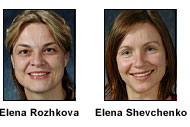
Argonne's Center for Nanoscale Materials Adds 2 Researchers
 Elena Rozhkova and Elena Shevchenko have joined the NanoBio Interfaces Group of the Center for Nanoscale Materials (CNM) at Argonne National Laboratory in Argonne, Ill., the lab announced. Rozhkova most recently worked as a research associate in the biological division at the University of Chicago, where she focused on biofunctionalized nanocomposites for biomedical and environmental applications. She earned her PhD in chemistry from Moscow State Academy of Fine Chemical Technology in Russia. As a Japan Society for Promotion of Science (JSPS) postdoctoral fellow, Rozhkova conducted research on iron-oxygenases at Tohoku University's Multidisciplinary Institute for Advanced Materials. Later she continued her research in the field of metalloproteins at Princeton University. A member of the American Chemical Society, Rozhkova has written and collaborated on 23 peer-reviewed publications and has been awarded two patents. Shevchenko previously worked as a staff scientist at Lawrence Berkeley National Laboratory conducting nanoparticles research, and before that at the IBM Watson Research Center and Columbia University. She earned her PhD in chemistry from the University of Hamburg in Germany. She is a member of the Materials Research Society and the German Physical Chemistry Society and her work has appeared in 32 peer-reviewed publications. "With their assistance we will continue our integration of soft biological and organic molecular assemblies with hard inorganic nanoarchitectures to be applied to chemical catalysis, sensors, energy and information storage, developing new cures for cancer and biological intervention," said Tijana Rajh, Argonne's CNM NanoBio Interfaces Group leader.
Elena Rozhkova and Elena Shevchenko have joined the NanoBio Interfaces Group of the Center for Nanoscale Materials (CNM) at Argonne National Laboratory in Argonne, Ill., the lab announced. Rozhkova most recently worked as a research associate in the biological division at the University of Chicago, where she focused on biofunctionalized nanocomposites for biomedical and environmental applications. She earned her PhD in chemistry from Moscow State Academy of Fine Chemical Technology in Russia. As a Japan Society for Promotion of Science (JSPS) postdoctoral fellow, Rozhkova conducted research on iron-oxygenases at Tohoku University's Multidisciplinary Institute for Advanced Materials. Later she continued her research in the field of metalloproteins at Princeton University. A member of the American Chemical Society, Rozhkova has written and collaborated on 23 peer-reviewed publications and has been awarded two patents. Shevchenko previously worked as a staff scientist at Lawrence Berkeley National Laboratory conducting nanoparticles research, and before that at the IBM Watson Research Center and Columbia University. She earned her PhD in chemistry from the University of Hamburg in Germany. She is a member of the Materials Research Society and the German Physical Chemistry Society and her work has appeared in 32 peer-reviewed publications. "With their assistance we will continue our integration of soft biological and organic molecular assemblies with hard inorganic nanoarchitectures to be applied to chemical catalysis, sensors, energy and information storage, developing new cures for cancer and biological intervention," said Tijana Rajh, Argonne's CNM NanoBio Interfaces Group leader.
Published: September 2007